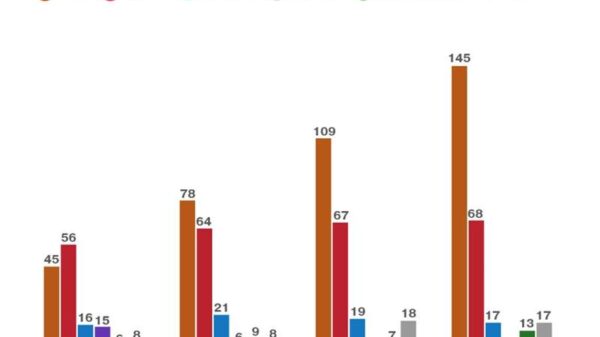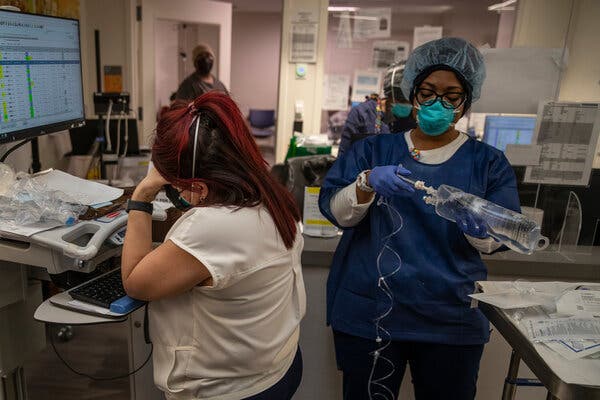A young man poked his head out of an isolation room and demanded, not for the first time, to know the Covid-19 test result he was waiting for. He kept asking until Natasha Williams looked up.
At that moment, Ms. Williams was one of only two nurses working on the Covid-19 ward, with its 36 patients. The young man was the healthiest in sight.
One of the patients might die before the day was done, she worried. A few were on ventilators. One was curled in a fetal position and moaning for water; another was asking to eat. Patients were crammed into every corner, their gurneys arranged, Ms. Williams thought, like blocks in a game of Tetris.
“We’re all busy,” she called out to the young man, calmly but with a hint of irritation. “We’re not here twiddling our thumbs. You’re going to have to be patient.”
The nature of the Omicron variant and the widespread use of vaccines have made the current coronavirus wave less severe in some ways than earlier ones. But it did not feel that way at 1:02 p.m. on Wednesday, almost halfway through Ms. Williams’s 12-hour shift in the emergency room at the Brooklyn Hospital Center.
She took a deep breath behind her turquoise-colored N95 mask, trying to dispel the constricting anxiety that came from what she described as “being pulled in too many directions at once.” Then she turned her attention back to the task that kept getting interrupted: searching for a vein in the gaunt arm of a 70-year-old woman, a Covid-19 patient in need of screening for sepsis.
Like many hospitals in New York City, the Brooklyn Hospital Center is straining under the biggest surge of Covid-19 patients since spring 2020, when ambulance sirens filled the air and more than 20,000 New York City residents died.
In the pandemic’s early days, doctors and nurses looked out on emergency rooms filled with patients who were desperate for oxygen. Today, Covid-19 patients’ symptoms are generally milder — stomach aches, fainting, dizziness, nausea, some shortness of breath — and far fewer people are dying.
But the patients keep arriving, and in droves: More than 15,000 people with Covid-19 have been hospitalized in the city in the past four weeks, the most since the initial surge. About half of all patients in the city’s hospitals now have Covid-19.
And there are simply not enough nurses to care for them all. Across New York, hospitals generally employ fewer nurses than they did at the start of the pandemic, according to the New York State Nurses Association, a union.
Some nurses, burned out by stress, have left the profession; others have taken traveling nurse jobs at considerably higher pay. And the Omicron variant’s extreme infectiousness has meant many are out sick or in isolation on any given day.
Dr. Sylvie de Souza, who runs the Brooklyn Hospital Center’s emergency room, said she had enough doctors but had never had so few nurses. Some days, she only had three-quarters of the nurses she needed. On Wednesday, it was closer to half.
“During the first wave we were able-bodied,” she said. “But now we’re exhausted and many are ill.”
On Wednesday, Dr. de Souza arrived before 8 a.m. and left around 11 p.m., her typical schedule during peak Covid-19 periods. She pitched in wherever she could, at one point filling cups at a water cooler and passing them out to patients, some of whose lips were dry and cracked.
But the camaraderie that helped sustain hospital workers in early 2020 — when, draped in garbage bags for lack of protective equipment, they faced a deadly new pathogen — sometimes felt as though it had worn thin.
“Please, that vanished pretty quickly,” said Ms. Williams, who was on maternity leave during the first Covid-19 wave and returned to work in June 2020.
Today, nurses are vaccinated, and conditions are far safer than before. But many, in interviews at hospitals across the city, described feeling abandoned, left to care for a crushing number of patients whose needs they cannot meet.
The strain is especially acute at the Brooklyn Hospital Center, a safety-net hospital in Downtown Brooklyn, where patients tend to be working-class or poor.
“It’s busy here,” said Bonita Figueroa, 70, the woman whose arm Ms. Williams was searching for a vein. Her comment was part complaint, part sympathy. Ms. Figueroa had Covid-19, but doctors were also worried that she might have sepsis.
Ms. Williams affixed a thin blue tourniquet to Ms. Figueroa’s arm and asked her to make a fist. Just then, another nurse called out: She was holding a blood bag for a different patient and needed Ms. Williams’s help. That was a higher priority.
Ms. Williams removed the blue band from Ms. Figueroa’s arm and patted her hand.
“I’ll get to you soon,” she said with a sigh.
Dropping what you are doing to run to the sickest patient is a big part of emergency medicine. But with so few nurses, the basic tasks had become difficult to get to, and new ones kept piling up. Several members of the medical staff said they felt they were letting their patients down.
Ms. Williams and another nurse prepared the blood transfusion, each confirming that the blood types matched. The patient, sick with Covid-19, was bleeding internally. She writhed in her hospital bed and was uncommunicative, even as Ms. Williams tried to reach her.
“Where are you feeling pain?” Ms. Williams asked.
No answer.
Just then, another patient arrived at the Covid ward: a nursing home resident whose toes twitched beneath her hospital blanket as she rolled by slowly on a gurney. “Beep, beep,” said the hospital worker pushing the woman, navigating the narrow lane between other gurneys in search of a place to put her.
A few minutes later, Ms. Williams returned to Ms. Figueroa, reapplying the tourniquet and searching again for a vein. “We’re going to try again,” she said.
The Brooklyn Hospital Center took in wounded soldiers during the Civil War, and treated workers suffering from the bends during the construction of “Bridge No. 3,” known now as the Manhattan Bridge. Standing next to Fort Greene Park, its higher elevation was once said to hasten patient recoveries. Dr. Anthony Fauci was born here.
As other community hospitals merged with larger systems, the Brooklyn Hospital Center remained independent, its finances precarious at times. Most of its patients are Black. More than twice as many rely on Medicaid as on commercial insurance.
During the pandemic’s first wave, the hospital attracted national attention after a series of articles in The New York Times and a video posted online that showed a forklift placing a body into a makeshift morgue outside.
Dr. de Souza helped lead the hospital through the terrifying first wave, when she and many colleagues were infected. In late December, as the Omicron variant tore through New York, she ordered the emergency room divided in half with plastic sheeting to try to keep patients with Covid-19 away from the rest. They had not done that since the first wave.
The Coronavirus Pandemic: Key Things to Know
The latest Covid data in the U.S. As the Omicron surge caused case counts to reach record highs and hospitalizations to surpass last winter’s peak, here’s what the data suggests about the variant’s potential toll. Reports of falling infection rates in parts of the U.S., meanwhile, hint that a national peak may be approaching.
There are growing signs that Omicron’s spread peaked in the city at the end of December or in early January. But the number of hospitalized Covid-19 patients has continued to rise.
Dr. de Souza said that the emergency room had more Covid-19 patients last week than at any point since the first wave. On Tuesday, four such patients, including a retired doctor, died in the emergency room, Dr. de Souza said.
On Wednesday, a tear streamed down her cheek as she looked out on patients. More kept arriving, with many staying for days. There was little room for them upstairs. The 18 intensive care beds on the hospital’s sixth floor were full, mainly with Covid-19 patients.
The Covid patients were older, generally over 60. Some had come from nursing homes. Just over half were unvaccinated.
Weldon Kennedy, 59, said he arrived in the emergency room about a week ago, with what he thought was a heart attack. He did not know he had Covid-19 until he got to the hospital. He laughed ruefully, before a hacking cough took over.
“The cough takes everything out of you,” he said, “like it’s trying to take the last breath.”
The patient next to him, Laverne Cook, 68, began to stir. She had oxygen tubes in her nostrils and she said she was beginning to feel better. She had arrived about five hours earlier. Dizzy, weak and struggling to breathe, she had called an ambulance. Although fully vaccinated, she had not gotten a booster shot, ignoring her granddaughter’s pleas.
“I wasn’t really scared because I hadn’t gotten Covid the first time,” she said. “But it fooled me.”
It occurred to her that she had not eaten a real meal since Sunday. Now she was feeling hungry.
Other patients were getting worse. Ms. Williams described having to search for a cardiac monitor for a patient whose breathing was ailing. When she finally found one, a crucial wire was missing, and the search continued.
Some days, she said, there was no time to check a patient’s vital signs. “They’re not being done, because there is no staff,” she said.
She began distributing medication, but she could not get to every patient she had hoped to. And new ones kept arriving.
By late afternoon, she began to wash a large woman caked in feces. Upstairs, a bed had opened up, and the patient was being transferred. Other patients needed medication and to have blood drawn, but right now this felt like the priority.
“I’m not going to send her upstairs dirty,” Ms. Williams said.
When Ms. Williams feels overwhelmed, she tries to put herself in her patients’ place. “I just keep thinking that could be me one day or that could be my mom,” she said.
How many times a day could she do that? The problem was not a lack of motivation or heart. It was just math. Too many patients; too few nurses.
“It hurts, but I can’t do everything,” she said as she drove home after her shift. “I do what I can do.”































